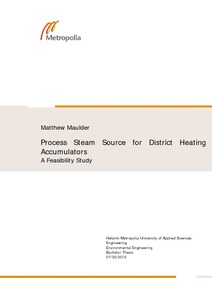A Feasibility Study of Process Steam Sourcing for District Heating Accumulators
Maulder, Matthew (2012)
Maulder, Matthew
Metropolia Ammattikorkeakoulu
2012
All rights reserved
Julkaisun pysyvä osoite on
https://urn.fi/URN:NBN:fi:amk-201203133297
https://urn.fi/URN:NBN:fi:amk-201203133297
Tiivistelmä
Steam generation plays an important role in the operation of district heating accumulators. Each district heating accumulator requires a layer of steam above atmospheric pressure filling the open space above the process water within. The aim of this steam layer is to maintain a low oxygen environment within the district heating accumulators to reduce the likelihood of corrosion. Helsingin Energia’s Salmisaari combined heat and power plant required a new steam generator solution to fulfil the summer requirements. The purpose of this thesis is to analyse the feasibility of different steam generation options from a technical and economic view point.
The methodology utilised involved estimating the current system parameters including power of steam required, steam consumption profile, capacity factor, energy required and available fuels. Once these parameters were defined, suitable steam generation methods were compared based on technical and economic feasibility.
The results of the above mentioned methodology showed several possibilities. The possible steam generation methods were to purchase and install a new electric resistor for the existing steam generator or purchase and install a combustion derived steam generator using light or heavy fuel oil. The third option available was to continue using the current heavy fuel oil fired auxiliary boiler for steam production and to cease the use of the district heating accumulators during the annual overhaul of the heavy fuel oil fired boiler.
The conclusions of this thesis indicate that the purchase and installation of an electric resistor is the optimal solution to this problem. The investment of a new electric resistor would be comparably low and require minimal process changes. Economically the use of an electric resistor to produce the process steam would be comparable to the heavy fuel oil boiler costs and lower than light fuel oil steam generation costs.
The methodology utilised involved estimating the current system parameters including power of steam required, steam consumption profile, capacity factor, energy required and available fuels. Once these parameters were defined, suitable steam generation methods were compared based on technical and economic feasibility.
The results of the above mentioned methodology showed several possibilities. The possible steam generation methods were to purchase and install a new electric resistor for the existing steam generator or purchase and install a combustion derived steam generator using light or heavy fuel oil. The third option available was to continue using the current heavy fuel oil fired auxiliary boiler for steam production and to cease the use of the district heating accumulators during the annual overhaul of the heavy fuel oil fired boiler.
The conclusions of this thesis indicate that the purchase and installation of an electric resistor is the optimal solution to this problem. The investment of a new electric resistor would be comparably low and require minimal process changes. Economically the use of an electric resistor to produce the process steam would be comparable to the heavy fuel oil boiler costs and lower than light fuel oil steam generation costs.
